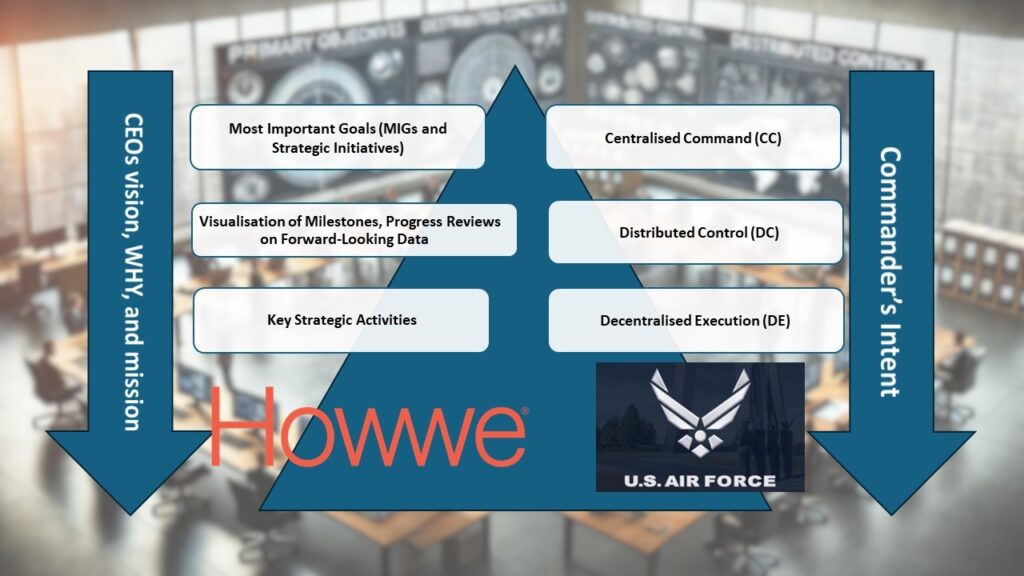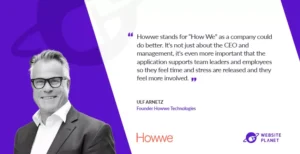According to the US Air Force Doctrine Publication 1 (AFDP 1), the method by which Airmen execute mission command is by “CC-DC-DE”, or:
Centralized Command (CC) – Distributed Control (DC) – Decentralized Execution (DE)
In contested battle situations, where communications may be degraded or limited any attempt to have centralized decision making would be ineffective and would impede the mission, so airmen are able to take decisions themselves knowing the “Commander’s Intent” or what mission command’s philosophy is. (Commander’s Intent: Attributed to Helmuth von Moltke – “provide subordinates only that information that they cannot determine on their own.” It defines what success looks like and provides a framework so that in the battlefield or in a stressful situation, systems and processes that support the mission are kept and subordinates can quickly adapt what needs to be changed without the need to refer to the core for decisions.
In business there is a lot of time taken planning to execute but not necessarily the same effort, time or rigour taken in executing the plan. Within the Howwe® methodology, and most definitely not being an expert in miltary strategy or planning, we would humbly submit that the above military framework can actually translate to Howwe® way of working as follows:
Centralized Command (CC):
- The company’s Most Important Goals (MIGs).
Set by the CEO/ C suite. The primary set of objectives that an organisation aims to achieve within a specific timeframe.
- Strategic Initiatives/ Must-win battles set top-down.
A strategic initiative outlines the comprehensive plan or set of strategic projects designed to enable the achievement of the Most Important Goal. The strategic initiatives are the overarching plan that guides the direction of the organization’s efforts, explaining HOW the goals will be achieved.
If these Strategic Initiatives are set bottom-up, then within the business the initiatives will not be ‘stretch’ and instead they will be linked only to the known organic growth above what you do or know now – not the strategic future or mission. It is imperative that these initiatives are set by the CEO/ CXO suite.
Distributed Control (DC):
- Commanders need visibility on the progress of the mission. CEOs need to know progress-to-plan. Where bottlenecks are, what teams are engaged or not engaged in executing the plan, where are resources concentrated, or where are more needed?
- Are resources aligned correctly and are they concentrated across the right Initiatives? Are these resources having the right effect? Are the initiatives looking far enough ahead in time or are only very short-term?
- Howwe® enables CEOs to get real-time views on the execution of their plan, so they can provide the right level of coaching, guidance or instructions to pivot. CEOs can actively control and drive the business and so on down through the leadership structure.
- Milestones provide the right level of agreement and linkage between the leaders driving the plan and the staff executing the plans. Agreeing milestones ahead of time is an important part of the planning and control process. Agreeing strategic and not BAU is tough, and that milestones are far enough out so that you do not just plan the next 4 weeks of activity.
- Progress is controlled in the Howwe® framework by the Acceleration Meeting which is vital to enhancing the communication fabric within the company, and ensuring mature proactive and constructive conversations happening that have a positive effect on driving the company’s plans forward. These happen bottom-up so by the time the CEO/ CXO suite meets the platform is totally up to date.
Decentralized Execution (DE):
- Within the Howwe® framework we call this micro-delegation, it is NOT micro-management. In the battlefield, commanders need their war fighters, navy personnel, airmen or soldiers to make decisions knowing or referencing the Commander’s Intent. They are not being centrally managed. Similarly, you do not want team leaders, going all the way up to the CEO to get involved in the day-to-day execution of the strategic activities.
- If milestones have been agreed and these are believed to be good enough to enable execution of the strategic initiatives, why not leave the execution to the teams responsible?
- Review the progress at the Acceleration Meeting and provide the necessary feedback, coaching or resources.
- Visualize your progress to strategic MIGs/ goals in Howwe® within five seconds and decide your actions as a team. Ensure that all involved are driving fast improvements. It is only Howwe® that can enable this.
- Encourage teams to build their own resourcefulness, taking the initiative for improving their cross-collaboration and communication skills. Watch them develop and grow with your nurturing.
Mission Command, a Unifying Framework
Mission Command provides a unifying framework for the development of USAF’s decentralized approach. Evolving USAF’s organizational structures and processes focused on the distribution of control ensures their airmen can continue operations in a decentralized manner despite the ‘fog and friction’ anticipated in a denied operating environment. According to the USAF’s doctrines, execution of ‘CC-DC-DE’ hinges on subordinates’ understanding of the Commander’s Intent. Commanders direct the ‘what and why’ and subordinate commanders devise the ‘how’. And, Commander’s Intent should ‘nest and align’ with the higher commanders’ guidance. Helping the success of the mission, there is a very clear delegation of authority. Commanders are accountable for the responsibilities they have been assigned. There is no room for excuses or for fudging data. The process of holding people accountable may well be uncomfortable for many, but it is vital for the success of the navy’s mission or indeed your very own business plan.
CEOs, and leaders at all levels, can visualize progress of all initiatives. Individuals provide their updates and their commitments to the team leader, at the Howwe-powered Acceleration Meeting. Binding the methodology of commitment inside the Howwe® platform is the unique way we blend improving everyone’s ownership, accountability and commitment towards the execution of the business plan. In this meeting everyone sees progress and the improvement in visibility helps everyone develop on improving their own capabilities. Providing commitments in a team environment ensures a mature, productive conversation regarding the progress of execution, enabling fast reallocation or reprioritization of resources.
Learning from the military’s successful deployment of leadership, delegation and control skills, we humbly suggest will help you drive and improve your own business’ plans.
Is it time for you to adopt and use similar, proven methodologies within your business and leverage the power of the proven methodology, within the Howwe® business-critical platform, to transform your business and watch your own ‘mission’ succeed on-time? Reach out and we’ll help you get started.





